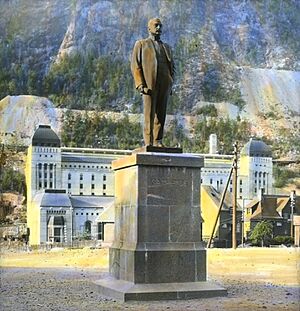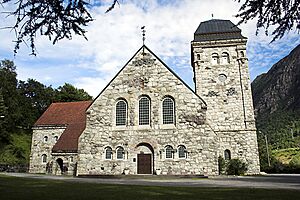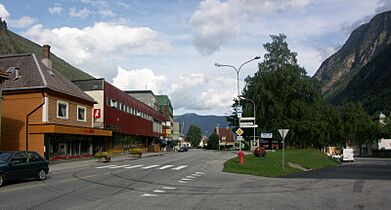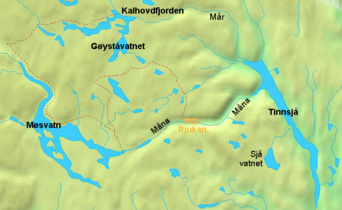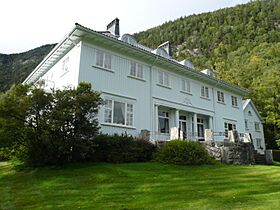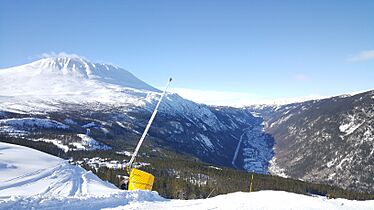Rjukan facts for kids
Quick facts for kids
Rjukan
|
|
|---|---|
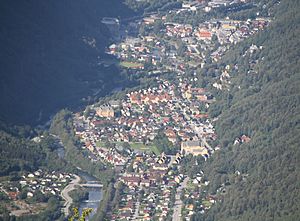
View of the town
|
|
| Country | Norway |
| Region | Eastern Norway |
| County | Telemark |
| District | Aust-Telemark |
| Municipality | Tinn Municipality |
| Established as | |
| Town (By) | 1996 |
| Area | |
| • Total | 2.59 km2 (1.00 sq mi) |
| Elevation | 300 m (1,000 ft) |
| Population
(2022)
|
|
| • Total | 3,003 |
| • Density | 1,160/km2 (3,000/sq mi) |
| Time zone | UTC+01:00 (CET) |
| • Summer (DST) | UTC+02:00 (CEST) |
| Post Code |
3660 Rjukan
|
Rjukan is a town in Tinn Municipality in Telemark county, Norway. It is the main town of Tinn Municipality. Rjukan is in the Vestfjorddalen valley, between the lakes Møsvatn and Tinnsjå. The town officially became a town in 1996. It is about 10 kilometers west of Miland village.
The town covers about 2.59 square kilometers. In 2021, Rjukan had 3,003 people living there.
Rjukan was built almost from nothing because of new industries. This happened in the 1910s and 1920s. The town got its name from the Rjukan Falls nearby. Rjukan was once a very important industrial area in Telemark. On July 5, 2015, it became a World Heritage Site. It is known as the Rjukan–Notodden Industrial Heritage Site. The town is also famous for the Norwegian heavy water sabotage during World War II. This happened at the Vemork power plant.
Rjukan does not get direct sunlight from September to March. This is because the tall Gaustatoppen mountain blocks the sun. In 2013, a special project called the Sunmirror in Rjukan was built. Large mirrors were placed on the mountain above the town. These mirrors reflect sunlight down into the town square during the dark months.
Contents
History of Rjukan
In 1906, the area where Rjukan now stands had only a few farms. It was called Saaheim back then. That year, a company called Norsk Hydro started planning to make fertilizer there. They used a new method called the Birkeland–Eyde process. Rjukan was chosen because the Rjukan Falls could make a lot of electricity. The waterfall has a 104-meter drop, which was perfect for power.
Building the Power Plants
The Vemork hydroelectric power plant was built between 1907 and 1911. At that time, it was the biggest hydroelectric power plant in the world. Another power plant was finished in Såheim in 1915. Building these plants cost a lot of money. It was like two years of Norway's national budget back then. Many houses were built for the factory workers. A train station and a town hall were also built. The town officially changed its name to Rjukan. By 1920, about 8,350 people lived there.
Rjukan and World War II
In 1934, Norsk Hydro built a hydrogen plant next to the Vemork power plant. This plant made a special substance called heavy water. Heavy water was a side product of making hydrogen. A famous scientist, Odd Hassel, told Norsk Hydro that they had the only regular heavy water production in Europe. At that time, people thought heavy water was needed to make a powerful weapon called an atomic bomb.
When Germany took over Norway during World War II, the Allies wanted to stop this production. They did not want Germany to get heavy water. The heavy water factory was attacked twice by the Norwegian resistance movement. Allied forces also bombed it. These actions are known as the Norwegian heavy water sabotage.
After 1960, Norsk Hydro moved most of its fertilizer production. It went to factories in Herøya in Porsgrunn.
Rjukan Church
Rjukan Church was built using natural stone. It has a tower at its entrance. The church was officially opened on December 21, 1915. Architects Carl and Jørgen Berner designed it. The church has a cross shape when seen from above. The altar painting was added in 1917 by Bernhard Folkestad. Stained glass windows were made by Torvald Moseid.
In 1965, during the filming of Heroes of Telemark, the church caught fire. Most of the inside of the church burned down. Only the walls were left. Asbjørn Stein was the architect for rebuilding it. The tower was badly damaged and had to be mostly rebuilt. Most of the original walls were used again. The church looked similar from the outside, but the inside was different. The church was ready again in 1968.
Tourism in Rjukan
Rjukan has been a popular place for tourists for a long time. This started in the 1800s, mostly because of the Rjukan Falls. A local resistance fighter and mountain guide, Claus Helberg, once called Rjukan "the start of tourism in Norway."
The Famous Waterfall
In 1811, a royal geologist named Jens Esmark "found" the Rjukan Falls. He excitedly told the King that he had found "the tallest of all known waterfalls." He thought it was 271 meters tall. But he was wrong. The waterfall is actually 238 meters tall. Its longest single drop is 104 meters. For comparison, the tallest waterfall in Norway, Skorga, is 875 meters tall.
Even so, the valley became a famous sight for rich European visitors. In the 1800s, two inns served guests from Norway and other countries. One guest was the French writer Jules Verne. He stayed in Rjukan in 1861. During his trip, he wrote The Lottery Ticket, an adventure story set in Telemark. In his book, he called the Rjukan Falls "one of the most spectacular waterfalls in Europe."
Activities for Tourists Today
Besides the waterfall, Rjukan has great areas for skiing. It is also a good starting point for hiking on the Hardangervidda plateau and Gaustatoppen mountain.
In 1968, Krokan, near the Rjukan waterfall, became the first cabin for the Norwegian Mountain Touring Association. After the waterfall was used for power, the cabin was sold. Today, it is open again and is part of the Unesco World Heritage site.
Today, people visit Rjukan for hiking. They also come for the local Gaustablikk ski resort. This is one of the biggest ski resorts in Norway. The Norwegian Industrial Workers Museum at Vemork is also a popular place to visit. Rjukan is also known as one of the best places for ice climbing in Northern Europe. This is because it has many waterfalls that freeze solid due to the lack of sun.
Gallery
See also
 In Spanish: Rjukan para niños
In Spanish: Rjukan para niños




